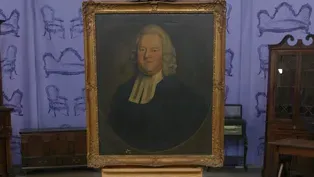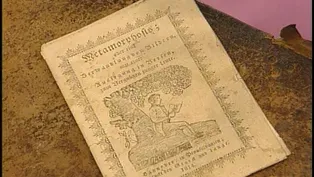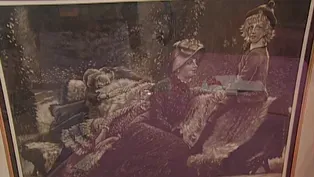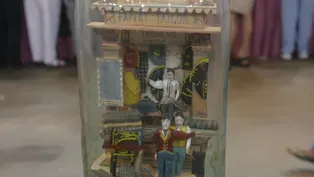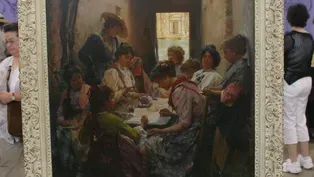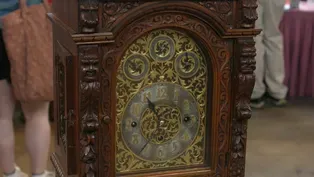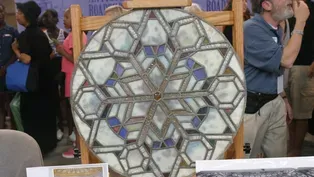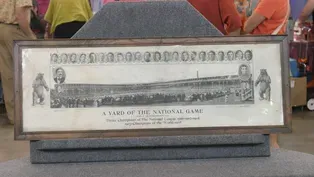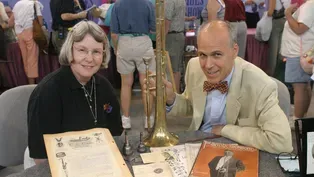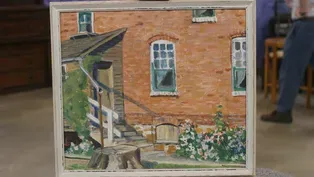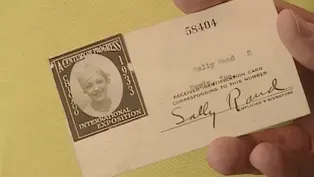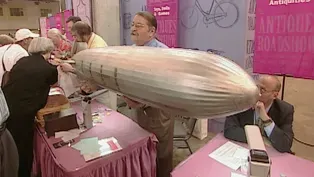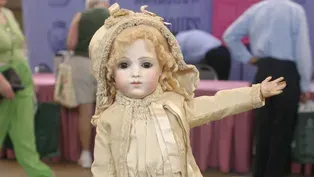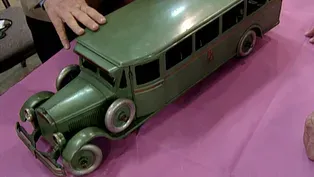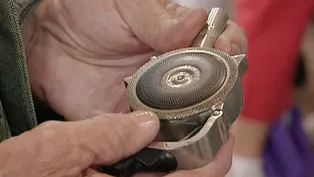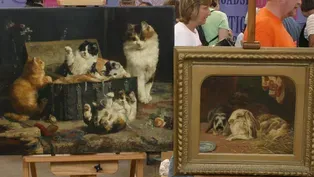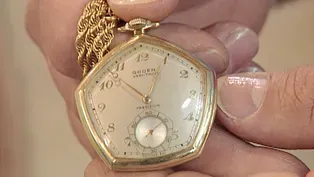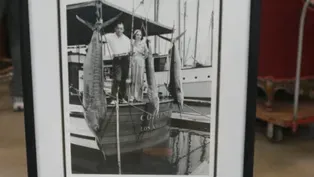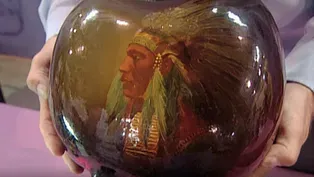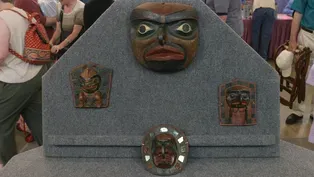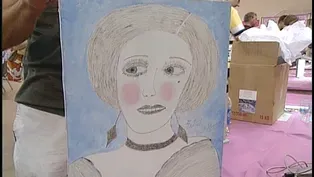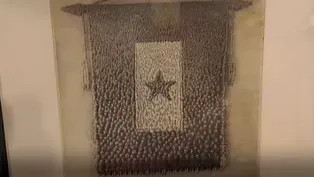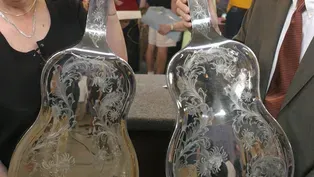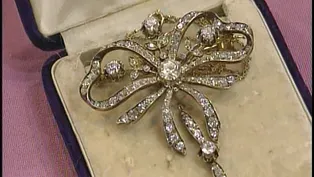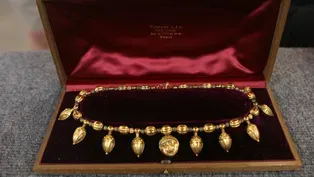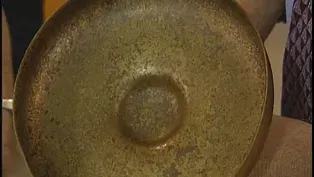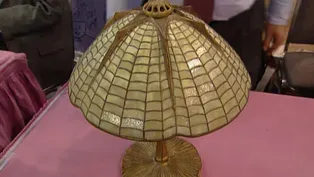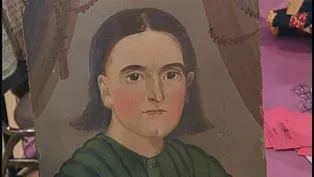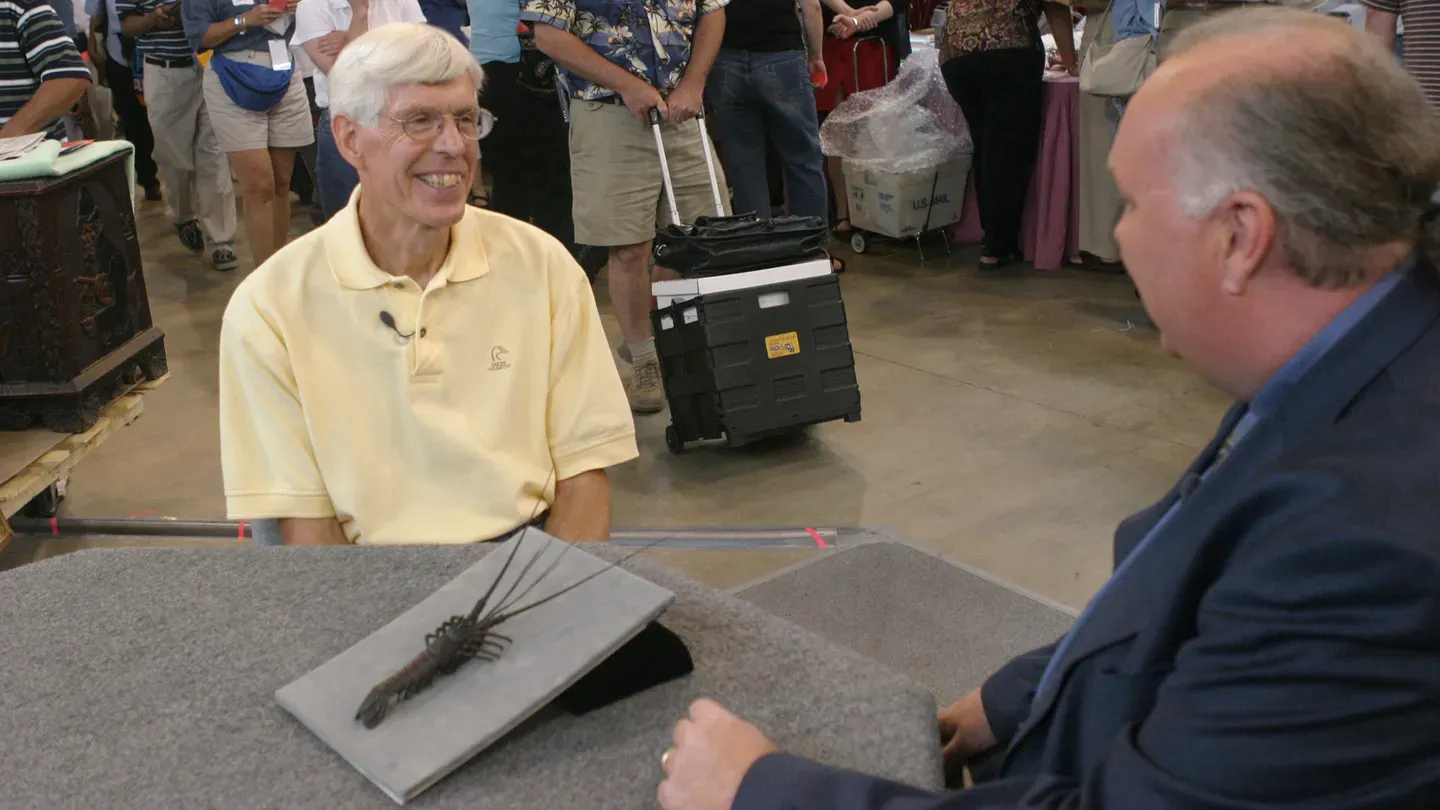

Vintage Chicago
Season 22 Episode 22 | 52m 31sVideo has Closed Captions
Learn which Windy City appraisals have soared and which have sunk since 2003.
Get transported back to ANTIQUES ROADSHOW’s second visit to the Second City for first-rate finds such as a 1908 Chicago Cubs presentation piece, a Tiffany & Co. gold necklace, and a 1904 Henry Woods oil. Which appraisals have soared and which have sunk in the marketplace since 2003?
Problems with Closed Captions? Closed Captioning Feedback
Problems with Closed Captions? Closed Captioning Feedback
Funding for ANTIQUES ROADSHOW is provided by Ancestry and American Cruise Lines. Additional funding is provided by public television viewers.

Vintage Chicago
Season 22 Episode 22 | 52m 31sVideo has Closed Captions
Get transported back to ANTIQUES ROADSHOW’s second visit to the Second City for first-rate finds such as a 1908 Chicago Cubs presentation piece, a Tiffany & Co. gold necklace, and a 1904 Henry Woods oil. Which appraisals have soared and which have sunk in the marketplace since 2003?
Problems with Closed Captions? Closed Captioning Feedback
How to Watch Antiques Roadshow
Antiques Roadshow is available to stream on pbs.org and the free PBS App, available on iPhone, Apple TV, Android TV, Android smartphones, Amazon Fire TV, Amazon Fire Tablet, Roku, Samsung Smart TV, and Vizio.
Buy Now

ANTIQUES ROADSHOW 2025 Tour!
Enter now for a chance to win free tickets to ANTIQUES ROADSHOW's 2025 Tour! Plus, see which cities we're headed to!Providing Support for PBS.org
Learn Moreabout PBS online sponsorshipThis crayfish that you have here is actually made out of iron.
But all we need for this one is a little bit of cocktail sauce.
Yes.
Three of these masks represent a thunderbird.
One of the masks is a beaver.
And we can tell that by these big buck teeth here.
♪ ♪ WALBERG: In 22 years, "Antiques Roadshow" has stopped in Chicago three times.
And in all those visits, one thing remained the same.
APPRAISER: The fact that the Cubs haven't been to a World Series since 1945, and they haven't won since 1908.
WALBERG: A lot can change with the passage of time, including the hometown Cubbies winning the World Series in 2016.
Let's see if the estimate for this winning photo has changed since 2003, and if the values of our other Windy City treasures have gone up, down, or stayed the same in this fresh look at Chicago.
MAN: We were at this estate sale in the Highland Park area.
I noticed the oak frame, and I proceeded to wipe off the glass.
It was quite soiled.
And I seen some of the artwork here, and a portion of a baseball field.
So what was the princely sum that you paid?
He was quite adamant about the price.
It was $20 firm.
This is actually what they call a presentation piece, and this was given out to celebrate the fact that the Cubs had won the World Series in 1907 and 1908, the first team ever to do that.
Of course, the World Series started in 1903.
This presentation piece is actually a photo of West Side Grounds, and it shows here all the players from the 1908 team.
This was given out to players on the team, and it was given out to executives.
This was the greatest decade that the Cubs ever enjoyed success, but they haven't been to a World Series since 1945, and they haven't won since 1908.
Let me tell you a little bit about the cast of characters.
First guy up, we have Mordecai Brown.
Mordecai was also known as "Three Finger," because he was at his uncle's farm and his hand got caught in the corn shredder, and it actually took off his finger right down to the nub here in the second knuckle.
Oh, my... Later, he fell and broke two other fingers, so his hand was like this.
But for him, he could grip the ball better, and it would dip when he would throw it.
He was actually Christy Mathewson's great rival in the early 1900s.
He pitched a shutout in the 1907 series, and in 1908, he won twice.
So he was a huge component of this team in pitching.
Now, defense.
You may have heard of Tinker to Evers to Chance.
Yes.
Joe Tinker, shortstop, Johnny Evers, second baseman, Frank Chance, first baseman.
They're probably the best-known double play combination.
The funny thing was, they were together for ten years-- they did not get along.
In fact, Tinker and Evers didn't talk to one another for 33 years after they had an argument in 1905 over cab fare.
But Frank Chance went on, and he managed the team, and he played.
So you can see, they had a magnificent team here.
And their era really ended in 1910, when they lost to the Philadelphia A's.
This is valued at about $5,000.
Oh, my.
That's shocking-- that's amazing.
But if it were in great condition, $20,000.
Oh, my gosh.
MAN: My father collected arms and armor, and this was always one of my favorite items.
Well, there's a great deal of connection with his collecting and what this object is.
This object was probably made by a family called the Myochin.
And the Myochin were armorers, that used to make armor.
But it turns out, in the middle part of the 19th century, the feudal system collapsed in Japan, and there was no need for these people to do anything.
And what they started to do was make tourist objects like this.
And this crayfish that you have here is actually made out of iron.
And it's completely articulated, totally moveable, and absolutely naturalistic.
This is an exact duplicate of the original little animal, with all these moveable parts, and as realistic as it conceivably can be.
And in fact, one of the things you notice is that color.
That color is actually an artificial color that's been put on it to make it look even more natural.
And then, if you reverse the item, and you see the bottom of the piece, you can see all the little articulations and moveable parts that would be on a live lobster, but in this case, recreated in iron.
It's just a spectacular work, very, very finely done.
And one reason why I attribute it to the Myochin is, the Myochin were so good that it doesn't seem likely too many other people could've done one of this quality.
Now, of course, we get to the inevitable question: what did you think it was worth?
I don't know-- yes, I'm not sure.
Well, I sold another piece that was not attributable to the Myochin-- it wasn't as fine a quality.
And it was a completely articulated dragon.
And dragons are a much, much more common item.
I sold that for $10,000.
Hmm.
I would say a conservative price on this one would be $15,000.
Oh, well, great.
But all we need for this one is a little bit of cocktail sauce.
Yes.
(laugh) MAN: The watch belonged to my grandfather.
My father passed away about a year and a half ago, and I inherited it.
This watch was made in the 1940s.
There was a company, Dietrich Gruen.
And this has five sides.
Five sides for their 50th anniversary in 1944.
The value on this watch in today's current market is somewhere around $500.
MAN: This is a painting by Lee Godie, who was a naive artist who worked in Chicago late '70s, '80s, into the '90s.
She kind of looked like the bird lady in "Mary Poppins," and was very, very suspicious of most people.
So before she'd sell you a painting, she'd have to talk to you and check you out.
Says here a retail value of $30, but she gave it to me for $25.
So she really liked you.
Yeah, she liked me.
You know that this is Tiffany.
It's actually signed on the bottom "Tiffany Furnaces," and that was done, like, in the 1920s.
Most of the Tiffany that we see is from the 1890s and around 1900.
This is much later in their production.
The problem you have is in the condition here.
This is sort of worn.
It should be this really bright gold all over.
It's not quite round.
So it has condition problems, but it is an authentic piece of Tiffany.
I was born in 1929, and I figure I must've got it probably a year or two after that.
That makes complete sense, because that's exactly when it was made.
It is a Buddy "L," and that...
Buddy "L" was made in East Moline, Illinois, so it's appropriate we're in Chicago seeing a gorgeous Buddy "L" like this.
Now, you didn't really play with it much, did you?
Well, I thought I played with it quite a bit.
Quite a bit?
I remember even sitting on it when I was younger, and... Well, that's the great thing about Buddy "Ls"-- they're very durable.
They're made of sheet steel, like an automobile, and they're baked-on enamel...
I mean, they're very tough.
I mean, they even have a frame underneath like a real automobile.
And one of the interesting things about this toy, it was rideable.
You could steer it with the spare tire, which I love.
Yes.
And it has all the original decals.
It has 22 individual seats, two bench seats.
There's the original decal on the door.
It's in beautiful condition.
Has the decals on the front, the back.
Finding a Buddy "L" in this condition is very hard to do.
And what do you think it's worth?
If anything, I'd have to guess maybe $1,000.
Ten times that-- it's $10,000, easily.
This bus?
$10,000, easily.
Ten... Oh, my land.
Easily.
APPRAISER: This little book is a pocket version of the play "King Lear."
And it's illustrated by Eric Gill, who was a well-known British book illustrator in the 1920s.
WOMAN: Oh, great-- great.
Now, of course, what distinguishes it in this case is that it belonged to possibly the most famous member of the great Barrymore acting dynasty, John Barrymore.
And perhaps you'll tell us something about how it came to you.
All right.
The photo shows Elaine Barrymore, his fourth wife, and Barrymore in happier times there.
I met her through a mutual acquaintance in New York, who at that time dealt in entertainment memorabilia, but who became a very good friend of Elaine Barrymore.
Well, he was born in 1882.
Right.
And died in 1942.
'42, right.
And his fourth wife was actually 19.
When they met.
When they met, yes.
And he was, he was much, much older than that.
Yes.
And she just died in March of this year.
Well, in 1920, he did "Richard III," and in 1922, I think, he did "Hamlet."
His "Hamlet."
And here, we have "Lear."
Which is incredibly interesting, because here are his annotations.
We have diagrams here of characters, and of course, nearly all the Shakespeare tragedies are much too long.
So anybody directing or acting has to cut down things, and this is standard procedure.
This book was published in about 1935, so a mere seven years before his death.
Yes.
And the great tragedy, of course, is that he never played Lear.
And it was his life's ambition to play Lear.
To play Lear.
That was the one thing he really wanted to do.
Well, the whole package is fascinating.
I find these deletions thrilling.
There's a mark back here where he's written, "Out, treacherous villain," for emphasis, right there.
You have a large collection of Barrymore, have you?
Very large, but this is the thing I treasure the most.
This way, I get into his head, you know?
As an actor.
Yes.
Well, I think this is probably worth, on the retail market, about $3,000.
Oh, my.
John would be pleased.
Yes, he would, wouldn't he?
WOMAN: It is my grandmother's piece.
The story she was told was that it was brought over from Germany by a tailor by the last name of Meyers, and he had a tailor shop in Chicago, and he exhibited this at the Columbian Exposition of 1893.
He eventually moved to Belvidere, where my grandmother lives, and he passed away, and the rest of the people at the shop kept it, and when that shop went out of business, she approached the owner to buy it.
My grandmother paid five dollars for it.
Wow, interesting.
Well, it's a neat piece, and it's what's called in the trade a puzzle jug, or a puzzle bottle.
And the reason it's called a puzzle jug is because people always ask, "How did they do that?"
It's very similar to how they make the ship in the bottle.
The individual pieces were all prefabricated by the artisan beforehand, and then very, very carefully assembled inside the jug with very delicate, long and thin instruments.
And what's unique about this jug is the subject matter.
I mean, we often see religious scenes, Masonic scenes, but rarely is it like this tailor shop.
It's really a unique kind of scene.
It was probably actually made in this country.
He was probably from Germany.
What most people don't know about the Columbian Exposition is that not only was it a place to see wonders from all over the world, but it also had exhibits of local craftspeople in all categories-- in the decorative arts and in furniture, often awarding prizes for, you know, the best pieces.
Most likely, it was exhibited in an area for craftwork, and he probably used it as an opportunity to advertise his shop.
Here we can see, it's got a little paper label that discusses that it was a shop in Chicago, circa 1893, owned by Mr. Meyers.
So it ties not only a Chicago connection, but a great example of American Folk Art.
And because it's unusual and because of the subject matter, it kind of elevates it above your normal puzzle jug.
And I'd put its value, conservatively, somewhere in the $1,000 to $1,500 range.
It's a great piece, and it's unique, and I just love it, and I'm excited that you brought it in.
MAN: These were my wife's dad's masks.
And he worked with the forest rangers on the West Coast of British Columbia.
And I presume they were given to him by the Indians who he worked with.
By the Indians.
Do you know exactly where he worked out there on the West Coast?
Just that it was on the coast and above Vancouver.
Yeah, well, these are made on the north end of Vancouver Island.
Okay.
In a place, what's now known as Alert Bay, or Fort Rupert.
And they're made by a group of natives who used to be known as the Kwakiutl or the Kwakiuth.
Names are changing now to more appropriate names, and their appropriate name is the Kwakwaka'wakw, and those are the speakers of Kwakwala.
We have two different kinds of masks here.
The bottom three are known as frontlets.
And they were used by chiefs in social ceremonies at things like potlatches to honor a marriage or a change in rank.
And each one of these has a series of holes.
This one, three.
And affixed to this would've been a device like a hat, and it would've sat on the top of the head, the hat part, so that the mask sat on your forehead, hence the terminology, a frontlet.
And it shows inlays of abalone shell, which was a very prized shell on the West Coast of North America, and something we call poor man's abalone, which is mirror.
Yes.
It was cheaper to get old broken bits of mirror than to use the highly prized abalone shell.
These were used only by chiefs.
The mask above was used in something called a winter ceremonial, which was a form of theater.
It was only done during the wintertime.
It was used to enact mythical events of the past, done at night, and a dancer would've either had this strapped to his head or held it from behind as he told a story.
In collecting Native American art, there are some questions of legality in owning some of these things.
And that primarily has to do with, as it stands on the Northwest Coast, whether objects were owned singularly by an individual or collectively by a group.
These particular masks you have here were all owned singularly.
All of these would've been individual chiefs.
This would've been used by a dancer.
So there's no problems in the commercial market today about ownership of these-- they're perfectly legal.
Three of these masks represent a thunderbird, one of the masks is a beaver, and we can tell that by these big buck beaver teeth here.
Age-wise, late 19th, early 20th century, except for this.
This is definitely a 19th century.
Any sense at all of the value?
Oh, no, I have no idea.
None at all?
No idea.
Well, the frontlets-- this one, the beaver, is probably 1910, you're looking in the neighborhood of $6,000 to $8,000.
The thunderbird mask closest to you, slightly older.
I suspect these two masks were made by the same artist.
That's in the neighborhood of $8,000 to $10,000.
The lovely, round, moon-type mask with the thunderbird-- $10,000, $12,000, $14,000.
And again, another thunderbird.
I suspect these all came from the same family.
We're looking in the neighborhood of $20,000 to $25,000 on the large thunderbird.
That is hard to believe, really.
Very desirable, large market for these.
There's a reason why it's taken seven years to find masks like this coming to the Roadshow.
They're not that common.
Yes.
It's all people.
These are soldiers.
Mole and Thomas were Chicago-based photographers.
They began creating these performance pieces.
It kind of represents the best of American patriotism.
The emphasis is on teamwork.
APPRAISER: It's actually a rare piece of Weller pottery made in Zanesville, Ohio.
Really?
And what's rare about it is the subject matter, which is a Native American with the full headdress, which is very nice.
This piece is probably worth about $2,000.
No kidding!
Yeah, no kidding.
Oh, my mother would be thrilled!
She bought it with grocery money, I can assure you.
I can't believe that you brought this in.
I mean, this is a... 22 million people were at the Century of Progress Exhibition in 1933, and a lot of them saw this person, Sally Rand, do her fan dance for the first time.
For those who don't know, Sally Rand was famous for the fan dance because she was accused of dancing nude behind these exotic fans.
But of course, she was dancing in a body stocking.
But still, for 1933, pretty racy.
What's it worth?
There's only one of them for that year.
She came back in '34, but this is the only one for 1933.
$1,500, $2,000, $3,000...
I don't know.
I honestly don't know.
World's Fair collectors tend to be pretty cheap, but it's a great, great piece, and absolutely unique.
Well, I found it in an antique shop just hanging on the back wall.
Okay.
And I was very excited to find a metal-bodied instrument with a pretty picture on it.
You're an instrument collector, I take it.
Yes.
Okay.
Well, the thing that makes this so much more unusual than a run-of-the-mill instrument is, this is what we call trench art.
Okay.
Trench art was very popular in World War I.
It was typically made by convalescing troops that were wounded, and it was to keep them occupied during their convalescence.
Okay.
Most trench art that we see will be shells, artillery shells with decorations on them...
Right.
Little bullets, cigarette lighters, cigarette cases.
But in all the years I've been involved with military antiques, I've never seen a musical instrument made of brass shells.
Oh, really?
Okay.
It's dated September 20, 1917, and then the man's name who more than likely made it.
Apparently, he may have been a musical instrument maker before the war.
Right.
Because he knew how to fabricate a musical instrument, especially out of brass from military casings.
Trench art has become very popular in the last few years amongst collectors.
It's progressively going up and up and up in value.
Okay.
And something like this, it's kind of hard to put a value on.
You paid how much for it?
I paid, I think, $130 for it.
That was a very good buy.
I would estimate it $500, maybe $600, $700 for it.
Wow, excellent.
WOMAN: Back around the turn of the century, Marshall Field's put in a Men's Grill restaurant.
And Mrs. Field was in charge of decorating it, and she contracted with Tiffany to put in a ceiling.
Then, about 1948, Field's remodeled the restaurant.
Well, a friend of my in-laws was a carpenter on this job, and he asked if he could take some of the glass.
Then 1968, he asked us if we wanted this glass.
Mm-hmm.
But he said with the condition that we do not destroy it, and he gave us the history.
Then, about three years ago, I was going through Field's, and they had a display, including that picture, of the old Men's Grill.
You've brought a great piece of Chicago history, and you also brought a wonderful example of stained glass that was produced by the Tiffany Studios.
What's terrific is that in some way, part of the ceiling has survived.
Now, how many panels do you have?
We have four roundels.
Right.
We have two-- two-and-a-half, actually-- of a large panel.
Okay.
And we have this one we keep... that we put up in back of our bar.
Okay, well, if we look closely at the picture, you can see, right over there is one of the roundels.
Well, actually, many of the roundels, because they surrounded this big elliptical piece of glass here.
And then that piece right there is one of these rectangular vertical panels, and then this piece is one of the pieces that goes along the edge.
Now, the Great Fire happened in 1871, and after the Great Fire, it was time to rebuild the city.
Right.
And Chicago was very fortunate, because a lot of European stained glass artists came over to the country at this point.
There were over 50 firms that specialized in stained glass, but in this case, Tiffany was commissioned to do the work here, because he really was the most famous at the time for stained glass.
And what really surprised me when I saw this is that I'm looking at the style, and I thought, "You know, this looks as though it were Tiffany from the 1880s."
But then I started to think about it more, and I realized that he was trying to adapt to the style of the great Chicago glassmakers and architecture.
Okay.
And it has more of a prairie-style feel.
It's hard to put a value on something like this.
Right.
Because it has great historical importance.
But my feeling is that if the other panels are in the condition as yours is-- although there are some cracks in it...
Right.
I would estimate the total value of this collection at $35,000 to $45,000.
Thank you!
Well, thank you for coming!
It just...
It's just wonderful to see.
Oh, thank you very much.
I really appreciate it.
I really wanted to see some great stained glass in Chicago, and you brought it.
My father used to work at what was called Comiskey Park in the late '40s all the way till the early '60s.
And as a child, I used to be able to have the run of the place.
And I used to go out walking around the park.
I used to go in the clubhouse, go in the dugout.
I was up in the press box.
And it was a great time.
It was a great time to be out there, yeah.
Oh, it's like a kid's dream!
Aw, yeah, it was.
What did you bring today here?
Well, my father, through the years, has accumulated these baseballs, and they've been in a box in his closet for years.
I bring them out just to look at them, and we put them right back in there.
Some people said to put them out in display, and I said, "No, they're doing quite fine where they're at."
And I thought I'd bring them out today just to have them checked and look to see.
Yeah, well, basically, they range from the 1940s to the 1960s, and some of them are pretty special.
Uh-huh.
This one right here, for instance, is a 1957 Cleveland Indians ball.
And Roger Maris, his rookie year.
And here, he signed the ball right there.
That's pretty neat.
We have one from 1955, the Boston Red Sox, and there's Ted Williams-- signed the name right on the sweet spot, right over here.
Here, we have a 1952 New York Yankees ball.
And a very, very early Mickey Mantle signature right there.
The cherry of the bunch, and my favorite-- 1961 New York Yankees ball.
Ah.
Now, let me tell you how I know this is a '61 Yankees ball.
I mean, it's got everybody on it.
It's got Mantle.
It's got Yogi Berra.
But the most important signature on this ball isn't Roger Maris, it isn't Elston Howard.
It's this gentleman: Bob Hale.
Bob Hale played 11 games for the '61 Yankees, and that's it.
He didn't play for any other team that year, and 1961 was the year.
So here we have a group of baseballs.
You have a dozen in here.
Do you have any idea what they're worth?
I have no clue.
Never thought of... 'til today, they didn't come out.
Well, what if I told you that the '61 ball itself, because it's so immaculate-- you've kept them beautiful, and so did your dad-- what if I told you this was worth at least $3,000 to $5,000?
(blows through lips) Just that...
I would've never have dreamt that.
What if I told you the whole box?
$12,000 to $15,000.
You're kidding me.
Amazing.
Unbelievable.
Unbelievable.
It's incredible stuff!
Yeah.
Now, you were a lucky boy.
You've got four lucky little boys yourself.
Yes, I do.
My sons will be very happy about this.
WOMAN: This painting came into the family through my husband's Aunt Miriam, who was a very wealthy lady who enjoyed the finer things in life.
She traveled extensively around the world.
Right.
And this was one of her paintings.
And when she passed away, it went into my husband's mother and father's house, where it stayed for a very long time.
Right.
And a couple of years ago, we talked my father-in-law into letting us keep it in our house.
Uh-huh.
And we know it's a Henry Woods, or we think so.
Mm-hmm.
And we also have a book that came from 1915, an art show of his work, and we saw that it has an actual photograph of that picture.
I'm guessing about the family, but I suspect there may have been a smoker there.
Right, see how it's so much brighter in here than it is over here.
My husband's family smoked, heavily.
Yeah, I would have to say I get the sense that this painting had a four-pack-a-day habit.
Probably.
And I'm surprised these poor girls aren't coughing.
(laughs) The reason we can tell that, as you pointed out, we've got this wonderful little illustration.
It's the same painting.
But look at the difference.
The light coming through the doorway, and up here-- really needs a clean.
Yes.
I'm always telling people to get their paintings cleaned, but we have the advantage of actually knowing what it originally looked like.
Right.
Now, you've the book about Henry Woods.
What have you learned about him?
What I've learned is that he was an English artist who fell in love with Venice and became famous for his Venetian scenes.
And this painting is called "La Tombola," and it's a card game that they're playing called tombola.
But basically, that's all I know.
He was well known for depicting life in Venice.
He moved there when he was about 30 years old.
He was from Warrington, in England, where he studied art originally, before going on to the South Kensington Museum, which is now better known as the Victoria and Albert in London.
But as you say, like many artists before and since, he was seduced by Venice and the whole lifestyle, and it's his Venice scenes that are most popular.
But even while he was living there, he showed his work at the Royal Academy in London.
So the work was sent back over there, and he was, in fact, a very prestigious member of the academy.
And he was to live in Venice until his death in 1921.
Oh, okay.
This one, as we know from the book, dates from 1904.
Yes.
Now, he was also an illustrator early on, and I think we can see his skills as an illustrator coming out in this painting.
Interestingly, he actually illustrated books for some of the well-known Victorian writers like Trollope and also Wilkie Collins.
Hmm.
And I think when you look at the detail in these faces, really marvelous detail.
Oh, yeah.
Which I assure you will come up even more when it's been cleaned.
It's a really marvelous example of his work.
Now, value-- any thoughts about that?
I have absolutely no idea.
I mean, I don't think that we've ever cleaned it because we didn't know if it was real.
I think at auction, a painting of this caliber, by an artist as important as Henry Woods was, even without restoration, should easily fetch $30,000 to $50,000.
Wow-- really?
Yeah.
Wow, that's great.
APPRAISER: It is for young adolescents, called "Metamorphosis," published in Hanover, Pennsylvania, in 1814.
When you fold this open, instead of Adam, you have Eve, the transformation happens, and then she actually turns into something else.
Those books are extremely rare, they're so fragile.
We are probably looking at $3,000 to $4,000 for this pamphlet.
Wow.
My goodness.
The good thing is, it's very finely made.
The bad thing is, it's very big.
Yes.
So that does limit your marketability.
A zeppelin collector would love it, but also, it's a great decorative object.
Yes.
APPRAISER: Royal Doulton figurines, of course, millions of them have been made for a very long time, and they're all hand-painted.
And there's hundreds of different ones that Royal Doulton's made over the last 60, 80 years.
The super-rare ones have retained their value better than the common ones, and because yours are incredibly rare, I would say they're probably still worth, conservatively, at least $2,000 or $3,000 apiece.
Wow.
And maybe a little more.
Really?
These are great examples.
They were really a treat to see.
This was in my mother-in-law's house for probably 15 years.
She never hung it on the wall.
So I asked her if I could have it because it went really well with my house, and it's been hanging there, I've never had it appraised.
All I know is the artist's name, that's it.
Okay, let's start with the artist.
His name is James Jacques Tissot.
It's something called a mezzotint.
The title of the print is "Le Banc de Jardin" and it was made in 1883.
Oh.
Now, the most interesting thing about the print is that it's a proof.
There's about an inch space which is sort of dark, and the artist's name just scratched into the lower margin.
Later on, in the published edition, the lower margin is cleaned up, and you get cleaner text down here.
The regular edition of 500 would bring about $3,000 to $5,000.
Uh-huh.
This proof, at auction, would sell for between $4,000 and $6,000.
Wow.
So it was a nice acquisition on your part.
Wow.
Maybe she'll want it back!
(laughs): That's wonderful.
WOMAN: It was given to my husband-to-be in 1968 by a friend of the family, Mr. Zimmerman's son, who felt, because we loved music so, would enjoy having it.
He was very proud of his father, Leo Zimmerman, and his involvement with the Sousa band, and gave it to us, and we've kept it ever since.
Right, and Leo Zimmerman was a celebrated trombonist in John Philip Sousa's band.
I'll talk a little bit about the maker here, Charles Gerard Conn, an American success story.
He was a producer of rubber stamps, a decorated Civil War veteran.
He sold sewing machines, and he was a part-time horn player who had a lip injury, and he patented a very special mouthpiece.
From this, a business grew, and he started a company, C.G.
Conn, in Elkhart, Indiana.
If Conn is the Ford of brass instrument making, then Elkhart became the Detroit, because it became this great magnet for other makers, mass-producing them at a great scale, sending them out all around the world.
These manufacturers, and especially Conn, were adept at marketing these pieces.
And here we've got a great instance of endorsement.
Zimmerman was a well-respected and celebrated trombonist in the Sousa band, and we've got this wonderful history here and ephemera that comes along with it.
Sousa had a very strong linkage with Conn-- all the brass instruments were produced by Conn that they played with.
Conn was supplying them, Sousa was out helping him market them.
We looked at the serial numbers here, and in the beginning we thought maybe this was a little bit earlier from the documentation we have-- 1913 or so.
It turns out it's a horn from 1929.
So a bit post his career with, working with Sousa.
But a wonderful piece.
On the "Roadshow," we see a lot of instruments made by Conn, but rarely are they ones of this sort of quality.
Signed here, C.G.
Conn, Limited, Elkhart, Indiana, with wonderful engraving that terminates out of the bell and right up into the horn-- it's really a great piece.
Condition is immaculate.
And anyone playing it in the family or... Our son started to play it when he was in seventh grade, and was told by his teacher, "Do not bring it to school again.
It's too valuable."
But he does play the trombone to this day.
You know, this sort of package, topping it off with Zimmerman's custom mouthpieces here, along with the cutters, the John Philip Sousa ephemera, as well as the Zimmerman ephemera-- it's obviously not a piece you want to sell.
This is a family item.
I think for insurance purposes, you want to insure this in probably about the $3,000 range.
Very, very good.
WOMAN: I'm currently fixing my grandparents' home, and I came across a very heavy box in the attic.
I brought it downstairs and opened it up, and I found this cabinet, closed.
APPRAISER: Right.
And I opened it and found all this food in here wrapped in...
Wrapped in this Chicago newspaper.
Yeah, Chicago newspaper, World's Fair paper.
I was really surprised, so I found out that my uncle lost his apartment or home during the Depression because of the money problems, so he had to move back home.
And everything went in the attic.
Okay.
It just was frozen in time in the attic until I came across it.
Now, these are some of the spices and various tins that you found wrapped in these items, correct?
Right.
Right, they were all wrapped up, yes.
I want to preserve this for my family.
Great-- well, a couple of things, and I want to use this as an example.
You can see here that this is Menu sugar, which is a great advertising piece.
Okay.
But you can see that the box is a little crumpled here, and it does have the sugar in it.
Now, with all of these items, what you want to do is empty the product, okay?
Okay.
Having the product in there will only incite bugs to, you know, greatly attract them.
Okay, all right.
So you do want to get rid of that, because that will help preserve the integrity of the piece.
Okay.
Once you do that, and you can see here, if you go slowly and open this up, you can get a piece of cardboard in here that will help open this up and help preserve the piece, because that's where your value is going to be in, is in the condition and the quality of some of the graphics that are on these items.
And I would put an estimate on this of about $800 to $1,200 for the whole group.
And it could go higher because of the condition.
That's great.
Great.
Oh, he'd be happy.
Yes, he would.
He's up there watching this.
WOMAN: Well, I inherited them from my mother, who recently passed away.
And she started collecting antiques and folk art in the mid-'60s, when it wasn't very popular.
And she's always loved her animals, so she kind of combined the love of animals and antiques with these kind of paintings.
Animals have been painted forever.
In the 19th century, though, they took on two different styles of meaning.
The first piece, on the right, the "Fancy Rabbits," as the artist, A.J.
Simms, calls them, is really a very sort of straightforward, animal-as-animal portrait.
And an interior scene with a lovely dish, and just really sort of captures the feel of the animals.
The other piece, the wonderful cat portrait by Charles Van Den Eycken is the style of 19th-century animal painting that's about the animal, but also mischievous behaviors that sometimes humans have, as well.
And Van Den Eycken is a master of that style and medium.
He was best known for his animal paintings, his cat paintings, and this is a really elaborate one with the mother cat and the kittens and the jewelry box and the still life.
The painting just has everything, and it's almost as if you could just reach in there and pick up one of those sweet little kitties.
Do you know what she paid for them at all?
Well, my mother purchased the "Fancy Rabbits" in 1967 for $85.
Okay.
And she paid, in 1962, $250 for the cats.
And that was a lot of money back then, so she must've really loved it.
Wow.
She did a wonderful job.
The Simms I would value at probably between $2,000 and $4,000.
Oh, really?
But the really quintessential kitty painting and animal painting, the 19th-century view, is the Van Den Eycken.
And I would be putting that at between $15,000 and $25,000.
Really?!
Oh, yes.
Oh!
(laughs) It's wonderful!
APPRAISER: It's called the Chicago Palm Protector, and it was made by the Chicago Firearms Company.
It was manufactured in the 1890s.
In the 1890s, Chicago was a wide-open town, so there definitely a need for this type of a weapon.
Do you have any idea of its value?
I have absolutely no idea.
It's come down through the family.
Uh-huh.
Well, it's worth $2,000.
$2,000, whoa!
No problem with that.
All right.
Yeah, sounds real good.
All right.
WOMAN: My mother actually wanted to get rid of them, and I just thought they were quaint and kind of cute, and I would hang them up, so I took them.
APPRAISER: So you rescued them from the garbage bin.
Basically.
The whole group of four is worth about $30,000 to $50,000.
Wow-- oh, my.
And so when you talk to your mother tonight, and you remind her how she was going to throw them out... APPRAISER: It is a spider shade-- it looks like a spider web.
It is stamped Tiffany Studios New York.
I would put an auction estimate of $25,000 to $35,000 on it.
No!
$25,000 to $35,000, yes.
Oh, my goodness.
This is one of the better Tiffany lamps we've seen in a long time.
APPRAISER: We call this a bodice ornament, and it's around the turn of the century, but closer to 1880, I would say.
It's silver on gold.
And I found the hallmarks, and they are indeed Russian.
And I know that you thought it might have been bought at an auction in Russia, and you know what?
That is absolutely possible.
Any idea of value?
No, I haven't the faintest idea.
No?
I would say, in the market today, because of condition, rarity, and beauty, $15,000 to $20,000.
So I think you have something that's really to be treasured.
Oh!
(both laugh) WOMAN: I think I've had it about 60-plus years.
And I bought it from a gallery here in Chicago.
And it's by Grant Wood, who was an Iowa painter, and I'm from Iowa, so it had a sentimental attachment.
And I think the title of this is "A Doorstep in Amana," Amana, Iowa, which is an Amish community not too far away from where I was born.
I just wanted to know how it stacks up in his paintings.
I know it's not one of his significant ones.
Grant Wood, of course, is one of the premier American regionalists, spending most of his time painting in Iowa.
Of course, his perhaps most notable piece is the wonderful painting called "American Gothic," which shows the couple with the pitchfork.
But he also, of course, painted a lot of scenes of Iowa, rolling hills and things of that sort.
Early on, he did do a little work in Europe, and his European paintings were very much in the style of yours, although yours is actually from 1930, which is well into his established career.
This might've been something he would've done on site, because it's on a board, and it's small and it has sort of a spontaneous feel about it, which makes it very nice.
Do you remember how much you paid for the painting when you bought it so many years ago?
I regret that I have absolutely no recollection whatsoever.
But I think it was probably in the hundreds of dollars, not more.
In terms of the market, most people, when they think of Grant Wood, probably prefer his more typical subject matter.
Grant Wood is extremely popular.
His work is very marketable today.
Paintings like this have, in recent years, sold somewhere in the neighborhood of $30,000 to $50,000.
Like this one?
Yes, absolutely.
Last month, at an auction house, a painting of this size from Amana, of a cider mill, actually sold for $130,000.
My word.
Now, that's not to say that all works are in that range.
We'd have to see, if another one came on the market, if it in fact made it in the same league, then we could evaluate this one in that category.
Up to this past month, we'd probably have evaluated this in the range of $30,000 to $50,000.
Well, that's a good deal more than I paid for it.
You've brought us an extra special treat today.
We get to take a look at your identical twins.
They are my twins.
These are National steel guitars from about 1934, and these are special in that they are resonator guitars, and they have a very unique design, where instead of being a regular wooden box, we have these wonderful resonator cones, which actually are quite a bit louder than the usual acoustic guitar.
And these are affectionately known as National steel guitars, but they're not really steel.
They're actually made of brass, and they're covered with a nickel silver.
The engraving that we find on these is identical on the two guitars.
This one's their Lily of the Valley engraving.
It's what they called their style three.
And it's a pretty fancy engraving, also.
It's beautiful.
Up at the top, we have the National nameplate.
And that's engraved into a faceplate of pearloid, which is like an artificial mother of pearl, very popular at the time.
And we have our high nut here, which lifts the strings very high off the fingerboard so that it can be played with a metal slide.
Beautiful ebony fingerboard with diamond inlays.
And we come down into the sound chamber where we have this beautiful latticework done in metal.
That's a very distinctive design.
You won't find that in any other instrument.
Down here, behind this screen, we have the three resonator cones that actually vibrate and give it almost a sound that's more electric than acoustic.
Here we see more exquisite engraving on the sides, and also on the back.
And here we see the square neck, which is the signature of the lap-style guitar, and not the round neck of a Spanish guitar.
Now, we're going to lay it down.
Now, what is so special about these was that they are actually consecutive serial numbers.
Here we have number 2601, and this is actually number 2600, which happened to you completely by coincidence, right?
It did.
When I opened up the box from shipping it here, and I first saw that, my eyes just got huge.
I said, "Oh, I have a pair."
That's all I thought of.
Well, these are in wonderful condition.
I would estimate their value, each, at about $5,000, but because you have a pair that are consecutive serial numbers, this might be very meaningful to a particular collector who specializes in this sort of thing.
So I'd probably add another 20%.
Really?
Thank you so much for bringing them in today.
Thank you.
It was a real treat to get a look at your twins.
Thank you.
(playing blues tune) Beautiful sound.
The portrait is a distinguished ancestor of my wife, Kathy.
It's the Reverend Edward Holyoke, who was president of Harvard College for several years.
I think he was the second- longest ranking president of that school.
So we've had the portrait in our home for several years.
It's always occupied a place of honor.
Well, it's always an assist when you can see that a picture is signed.
And in this case, John Greenwood painted the picture in 1749.
And of course, you know a lot about the Reverend Holyoke, because he was the tenth president of a very important university.
How many students were at Harvard when he was the president?
My wife tells me 100.
100 students.
Well, it's grown quite a bit since then.
And tell me about the furniture, then.
Now, the chair, the family tradition has it the chair belonged to Reverend Holyoke.
But we know nothing about who made it or what it's worth or anything, so that's why we brought it, also.
Well, I can tell you, when I saw the chair, my heart started racing, because for many, many years, this form was always thought to have been made in Newport, Rhode Island, because of this shell.
People used to see that and say, "A-ha, a Newport shell."
Recent scholarship, however, has determined something quite different.
We now know that chairs of this type, with a beautiful scallop shell, with shell-carved knees, such as this, a return, a knee return like this, and most importantly, these very distinctive feet, were on Boston-made furniture.
And history has been rewritten now.
All of the early textbooks on American furniture stated that these chairs were made in Newport.
They weren't.
They were made in Boston.
That's interesting.
And I got very excited, because what a match with this fantastic history of Reverend Holyoke.
Chairs like this are highly prized in the American furniture world.
They were exported out of Boston to Newport, to New York.
They were very popular in the 18th century.
Did it ever occur to you that the value of the chair might even surpass this wonderful portrait?
Not at all-- I never had any idea that could be.
Colonial portraits signed by the artist are very rare, and this was probably rendered from life.
It really does appear as if the artist was looking at the Reverend Holyoke himself, and I would say it probably is in the neighborhood of $25,000 today in the market.
Oh, really?
Okay.
Maybe a little bit more.
I'd insure it for $25,000 to $30,000.
The chair... is extremely rare, in marvelous condition.
Chairs like this bring somewhere between $60,000 and $70,000 at auction.
Oh, my goodness.
WOMAN: I brought you a doll WOMAN: I brought you a doll that a neighbor gave me 45 years ago.
I loved her a lot and I played with her all the time.
But, maybe five years later, her head got broken.
APPRAISER: Oh, really?
Because I kept her wrapped up in clothes, and my sister was looking for a skirt, and she flipped out the clothes, and the doll came out and broke her head.
And I glued her, and that was okay for a while, but then, maybe 20 years ago, I had her head repaired.
Okay.
And I just wondered what you can tell me about her.
Well, it's a beautiful doll.
It's a French doll.
It's by a company called Bru in Paris.
This particular doll, called Bébé Modèle, came in in 1880 and probably lasted for about five years.
She's the first model child doll that the Bru factory produced.
It has a fully wooden articulated body, which is very unusual-- you can see by her toe there-- lovely face, lovely original dress, extra dresses, also original shoes.
Now, you told me about the damage on her head.
What we're going to do is, we're going to take off her hair and bring her around here.
And you can see inside her head where the crack is.
Anybody ever tell you about it, the value of it?
No, and especially since it was broken...
I knew it could be valuable, but because it was broken, thought maybe the value was lost.
I never really pursued it.
A woman who is knowledgeable about dolls said because the mouth was closed, it was not as valuable as if the mouth were open.
Oh, really?
Actually, a closed mouth is better than an open mouth.
Unfortunately, she did get damaged, but she's still pretty good.
I mean, you know, I would think...
Okay, with the repair on the head, probably $12,000 up to $18,000.
That's just the basic doll itself.
You have her shoes, which are marked Bru shoes with the "B" in the circle-- those are worth between $500 and $600 for her shoe.
(gasps) Her dress here, which is an original dress, pretty good condition, a few moth holes, probably $600 to $800.
Her walking outfit, probably around the same.
The extra dresses all, like, $100 to $150.
Whoa.
Without that crack in her head, between $20,000 and $30,000.
♪ ♪ WALBERG: I'm Mark Walberg.
Thanks for watching.
See you next time on "Antiques Roadshow."
Appraisal: 1749 Rev. Holyoke Portrait & Boston Chair
Video has Closed Captions
Appraisal: 1749 Rev. Holyoke Portrait & Boston Chair, in Vintage Chicago. (3m 12s)
Appraisal: 1814 "Metamorphosis" Children's Pamphlet
Video has Closed Captions
Appraisal: 1814 "Metamorphosis" Children's Pamphlet, in Vintage Chicago. (36s)
Appraisal: 1883 Tissot "Le Banc de Jardin" Proof
Video has Closed Captions
Appraisal: 1883 Tissot "Le Banc de Jardin" Proof, in Vintage Chicago. (1m 1s)
Appraisal: 1893 Carl Worner Folk Art Puzzle Jug
Video has Closed Captions
Appraisal: 1893 Carl Worner Folk Art Puzzle Jug, in Vintage Chicago. (2m 22s)
Appraisal: 1904 Henry Woods Painting
Video has Closed Captions
Appraisal: 1904 Henry Woods Painting, in Vintage Chicago. (3m 20s)
Appraisal: 1906 Black Walnut Pedestal Clock
Video has Closed Captions
Appraisal: 1906 Black Walnut Pedestal Clock, in Vintage Chicago. (1m 3s)
Appraisal: 1907 Tiffany Studios Stained Glass Panels
Video has Closed Captions
Appraisal: 1907 Tiffany Studios Stained Glass Panels, in Vintage Chicago. (3m 2s)
Appraisal: 1908 Chicago Cubs Presentation Piece
Video has Closed Captions
Appraisal: 1908 Chicago Cubs Presentation Piece, in Vintage Chicago. (2m 31s)
Appraisal: 1929 C.G. Conn Trombone with Ephemera
Video has Closed Captions
Appraisal: 1929 C.G. Conn Trombone with Ephemera, in Vintage Chicago. (3m 9s)
Appraisal: 1930 Grant Wood Oil Painting
Video has Closed Captions
Appraisal: 1930 Grant Wood Oil Painting, in Vintage Chicago. (2m 35s)
Appraisal: 1933 Sally Rand International Exposition ID
Video has Closed Captions
Appraisal: 1933 Sally Rand International Exposition ID, in Vintage Chicago. (48s)
Appraisal: Airship Model, ca. 1935
Video has Closed Captions
Appraisal: Airship Model, ca. 1935, in Vintage Chicago. (17s)
Appraisal: Bru Doll & Accessories, ca. 1880
Video has Closed Captions
Appraisal: Bru Doll & Accessories, ca. 1880, in Vintage Chicago. (2m 30s)
Appraisal: Buddy "L" Toy Bus, ca. 1930
Video has Closed Captions
Appraisal: Buddy "L" Toy Bus, ca. 1930, in Vintage Chicago. (1m 25s)
Appraisal: Chicago Firearms Co. "Protector," ca. 1890
Video has Closed Captions
Appraisal: Chicago Firearms Co. "Protector," ca. 1890, in Vintage Chicago. (32s)
Appraisal: C. van den Eycken & A. J. Simms Paintings
Video has Closed Captions
Appraisal: C. van den Eycken & A. J. Simms Paintings, in Vintage Chicago. (2m 20s)
Appraisal: Dietrich Gruen Pentagonal Watch, ca. 1945
Video has Closed Captions
Appraisal: Dietrich Gruen Pentagonal Watch, ca. 1945, in Vintage Chicago. (30s)
Appraisal: George Ohr Vessel, ca. 1900
Video has Closed Captions
Appraisal: George Ohr Vessel, ca. 1900, in Vintage Chicago. (33s)
Appraisal: John Barrymore Annotated Script, ca. 1935
Video has Closed Captions
Appraisal: John Barrymore Annotated Script, ca. 1935, in Vintage Chicago. (2m 58s)
Appraisal: Karl Kappes Weller Pottery, ca. 1900
Video has Closed Captions
Appraisal: Karl Kappes Weller Pottery, ca. 1900, in Vintage Chicago. (23s)
Appraisal: Kwakwaka'wakw Masks, ca. 1900
Video has Closed Captions
Appraisal: Kwakwaka'wakw Masks, ca. 1900, in Vintage Chicago. (4m 1s)
Appraisal: Lee Godie Painting, ca. 1980
Video has Closed Captions
Appraisal: Lee Godie Painting, ca. 1980, in Vintage Chicago. (27s)
Appraisal: Mid-20th-Century Autographed Baseballs
Video has Closed Captions
Appraisal: Mid-20th-Century Autographed Baseballs, in Vintage Chicago. (2m 58s)
Appraisal: Mole & Thomas Studio Photo, ca. 1918
Video has Closed Captions
Appraisal: Mole & Thomas Studio Photo, ca. 1918, in Vintage Chicago. (21s)
Appraisal: National Tri-cone Steel Guitars, ca. 1934
Video has Closed Captions
Appraisal: National Tri-cone Steel Guitars, ca. 1934, in Vintage Chicago. (3m 5s)
Appraisal: Royal Doulton Figurines, ca. 1935
Video has Closed Captions
Appraisal: Royal Doulton Figurines, ca. 1935, in Vintage Chicago. (31s)
Appraisal: Russian Diamond Brooch, ca. 1880
Video has Closed Captions
Appraisal: Russian Diamond Brooch, ca. 1880, in Vintage Chicago. (46s)
Appraisal: Tiffany & Co. Gold Necklace, ca. 1860
Video has Closed Captions
Appraisal: Tiffany & Co. Gold Necklace, ca. 1860, in Vintage Chicago. (1m 3s)
Appraisal: Tiffany Furnaces Tazza, ca. 1925
Video has Closed Captions
Appraisal: Tiffany Furnaces Tazza, ca. 1925, in Vintage Chicago. (29s)
Appraisal: Tiffany Studios Spider Shade Lamp, ca. 1910
Video has Closed Captions
Appraisal: Tiffany Studios Spider Shade Lamp, ca. 1910, in Vintage Chicago. (22s)
Appraisal: William Matthew Prior Portraits
Video has Closed Captions
Appraisal: William Matthew Prior Portraits, in Vintage Chicago. (23s)
Providing Support for PBS.org
Learn Moreabout PBS online sponsorshipFunding for ANTIQUES ROADSHOW is provided by Ancestry and American Cruise Lines. Additional funding is provided by public television viewers.



